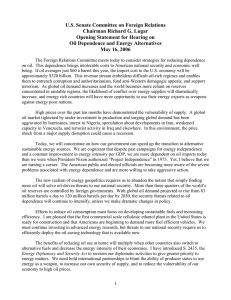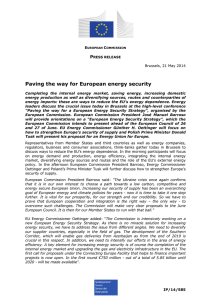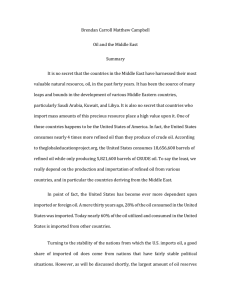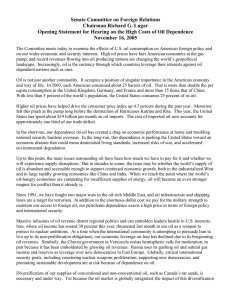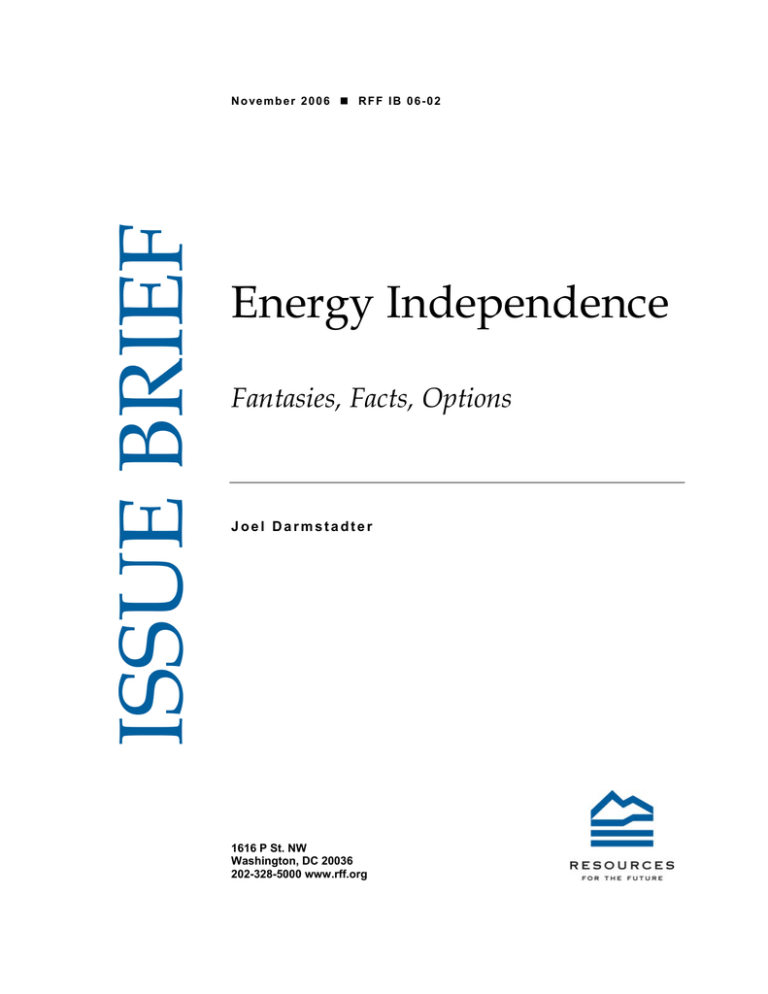
ISSUE BRIEF
N o ve m b e r 2 0 0 6 R F F I B 0 6 - 0 2
Energy Independence
Fantasies, Facts, Options
Joel Darmstadter
1616 P St. NW
Washington, DC 20036
202-328-5000 www.rff.org
Energy Independence: Fantasies, Facts, Options
Joel Darmstadter
Abstract
U.S. policymakers’ preoccupation with energy (meaning essentially oil) independence rests on a
distorted view of the world oil market. Given the largely integrated nature of that market, the fungibility
of global oil flows, and, thereby, prices equalized worldwide, it is U.S. oil dependence, rather than oilimport dependence that exposes the country to the macroeconomic impact of turmoil in world oil markets.
The discussion looks at demand- and supply-side measures to limit such vulnerability. Nontheless, the
national security interests of the country can be endangered by oil-related events abroad even in the
absence of the United States as a significant consumer.
Key Words: oil intensity, fungibility, geopolitical dimensions
JEL Classification Numbers: Q41, Q34
© 2006 Resources for the Future. All rights reserved. No portion of this paper may be reproduced without
permission of the authors.
Discussion papers are research materials circulated by their authors for purposes of information and discussion.
They have not necessarily undergone formal peer review.
Contents
Introduction............................................................................................................................. 1
The Myth of Energy Independence ....................................................................................... 2
Oil-Import Dependence versus Oil Intensity ...................................................................... 2
The Matter of Fungibility in a World Oil Market............................................................... 3
Cushioning Oil-Import Dependence ..................................................................................... 4
Supply-Side Options ........................................................................................................... 4
Demand-Side Options......................................................................................................... 7
Some Worrisome Geopolitical and National Security Ramifications ................................ 8
Table....................................................................................................................................... 11
Resources for the Future
Darmstadter
Energy Independence: Fantasies, Facts, Options
Joel Darmstadter∗
Introduction
In energy policy, lots of things are related to lots of other things—a platitudinous way to
begin perhaps, but worth a minute of our time.
Folks alarmed over our degree of oil-import dependence need to be reminded that
stemming the import tide isn’t without its own costs—monetary, environmental, or both. With
coal accounting for more than 55 percent of our electricity generation, turning additionally to
coal for conversion to liquids could compound environmental damage beyond what already
results from mountain-top removal and carbon dioxide (CO2) emissions, to name just two such
problems. On the other hand, forestalling more coal-burning electricity capacity by relying on
new nuclear plants confronts us with unresolved questions about nuclear power—cost, risk,
waste management, public acceptance, and its possible bearing on proliferation and safeguards.
Those concerned over oil-import dependence also face some unpalatable energy policy
choices: the tariff or other means we’re prepared to employ to limit imports. As well as some
tricky political dilemmas: is it all oil imports we seek to curtail—those from Canada as well as
the Persian Gulf—or only those from potentially unfriendly and unstable sources? Never mind
that yesterday’s stable and reliable supplier—like Venezuela pre-Hugo Chávez—may be
tomorrow’s quixotic exporter. And speaking of unfriendly oil suppliers, what stake do we have
in their petrodollar earnings not propping up hostile groups that threaten our national security?
Oil questions aren’t that far removed from geopolitical and national security dilemmas.
It would be reckless of me to try and work through all these intertwined byways. But let
me attempt to cover at least some of the issues that have—or should have more—public
visibility. Mostly, but not exclusively, my remarks will center on oil and, in particular, on how
America’s inescapable link to a single world oil market shapes the energy strategies and policies
the country might fruitfully pursue.
∗
Joel Darmstadter is a senior fellow at Resources for the Future in Washington, DC. He may be reached at
darmstadter@rff.org. This paper is a slightly revised version of remarks prepared for presentation at Arlington
Learning in Retirement Institute, George Mason University, November 1, 2006.
1
Resources for the Future
Darmstadter
The Myth of Energy Independence
Energy independence has been a rhetorical and political rallying cry for nearly 40
years—President Nixon presided over the massive 1974 Project Independence Report—and it is
as flaccid a concept today as it has been over the decades. To be sure, there are virtues in
reducing our oil consumption—and thereby our oil imports; among those imports, virtues exist
as well in striving for some geographic diversification in the origin of those imports. But with a
quarter, and possibly rising share of the nation’s overall energy consumption representing
imported oil that is producible much more cheaply than domestic oil, significantly stemming the
quantity of oil imports is entirely unrealistic. That is not to shrug off concerns over our
international payments problems and oil’s contribution to the trade deficit. At the same time,
anyone arguing the potential for even approaching self-reliance in oil has the burden of showing
how the cost—private and social—is worth bearing, considering the benefits.
This segues naturally to the next two themes I want to address—oil intensity and oil
fungibility.
Oil-Import Dependence versus Oil Intensity
From a purely economic perspective, any cost that we associate with our oil imports is, in
fact, a cost that stems from the level of our oil consumption. If we consumed zero imported oil
but an unchanged level of oil in the aggregate, chances are that, monetarily, we’d be just as much
in hock as before—simply because in an integrated world market, the price per barrel is the same
whether it’s imported or domestically produced oil that we’re consuming. If, on the other hand
(and at the extreme), we’d neither import nor consume measurable amounts of oil, it could help
immunize us to the volatility and perturbations on world oil markets. (By virtue of that same
phenomenon of an integrated world market, if we succeeded somehow of producing a greatly
expanded volume of domestic oil—large enough to appreciably increase worldwide supplies—
that could put downward pressure on world prices. People view that as the “supply-side” policy
option, which I’ll discuss later.)
So it’s quite important to focus on the extent to which we’re oil dependent, not merely
oil-import dependent. As it turns out, oil consumption per unit of real gross domestic product
(GDP)—call it an index of “oil intensity”—has declined by 50 percent over the last three
decades or so, suggesting that our vulnerability to the effect of turmoil in world oil markets,
while obviously still worrisome, is at least less than it would be at unchanged oil-intensity levels.
2
Resources for the Future
Darmstadter
There’s no single cause for that oil-intensity decline. Changes in industrial structure—
declining relative importance of (energy-intensive) manufacturing—is no doubt one factor. A
virtually complete elimination in the use of oil to generate electricity is another. And, coupled
with the adoption of automotive corporate average fuel economy (CAFE) standards, gasoline
price run-ups in the wake of the oil price increases following the Arab oil embargo and Iranian
revolution of the 1970s clearly did their part as well. Unhappily, some would say, the
conservation impulse in the transportation sector began to markedly flag by the mid-1980s as
world oil prices fell sharply. So whether, and with what incentives, that historic decline in oil
intensity can be sustained is a significant challenge. To meet it successfully may take more than
having President Bush hector us about our “oil addiction.”
The Matter of Fungibility in a World Oil Market
But let me revert with a bit more specificity to the matter of an integrated, fungible world
oil market, a concept captured by the notion that a price spike anywhere will spawn price spikes
everywhere. It doesn’t matter whether the precipitating event is belligerency in the Niger Delta, a
fire in a Gulf of Mexico refinery, or a Russian decision to restrict pipeline throughput as an
intimidating device. In other words, if, say, Nigeria’s shortfall requires its customer to bid for
supplies elsewhere in the world, an across-the-board price hike is virtually guaranteed: how else
to restore demand-supply equilibrium except through a price increase that, in effect, rations
diminished supply availability among undiminished worldwide claims for that supply?
Emergency stock releases aside (of which more in a moment), in the short run, spare
producing capacity around the world—whether of crude oil or refined products—that could
offset significant shortages is often severely limited. A couple of years ago, a gasoline shortage
in the United States led to an increased demand for imported European gasoline. Europe’s
drivers had to share the burden of the American shortfall by paying more. Broadly speaking,
then, fungibility means that oil and oil products will be routed across the globe so as to equalize
prices everywhere. To be sure, quality differentials and transport costs are qualifying factors in
this redeployment schema. But they aren’t major exceptions to what I’ve sketched out.
As a result, in the appended “basic” oil statistics table, there isn’t really the need for a
line showing our imports of Organization of the Petroleum Exporting Countries (OPEC) or
Persian Gulf oil. (For the record: during the first eight months of 2006, 40 and 16 percent of our
oil imports came, respectively, from these two sources.) The reason is that it doesn’t much
matter. Such a line in the table might be read to show how exposed the United States would be if
it was the target of an embargo, as it was in 1973–1974. But that episode, and its failure to
3
Resources for the Future
Darmstadter
achieve its penalizing objective, precisely points to the fact that in a world market, targeted
embargos don’t work, particularly if the “embargoing” country is loath to forego the revenues it
would lose if it chose to go the route of curtailing output. So, with the well-honed logistical skill
of the international oil companies and traders, embargoing countries are tacitly content to have
their deliveries to the United States diverted to country “X,” while country X’s supplier would
ship to the United States or enter the world oil pool, thus keeping prices to everyone more or less
level.
In short, embargos and preferential deals fail much more often than they succeed. At the
same time, I recognize that the future might not mimic the past and that categorical assertions
can be risky. Some caveats to this historical worldview, arising from national security
considerations, appear at the end of this paper.
Cushioning Oil-Import Dependence
It’s in everyone’s interest—the United States’ and the world’s—that prices signaled by
oil markets are low enough so as not to throttle economic growth but not so low—for example,
through subsidies or misguided regulations—as to deter more efficient use. In the former case, it
behooves us to seek ways of expanding oil supplies, in the latter case, to seek ways of promoting
and practicing economically justified conservation practices.
Supply-Side Options
On the supply side, even if the prospects for dispensing with a large part of our oil
imports is a pipedream, there are benefits to responding to short-term oil-supply disruptions,
diversifying the geographic sources of our oil, adding significant amounts to the global supply of
conventional crude oil, and pursuing efforts to develop a technologically and economically
viable synthetic fuels industry. Some thoughts on each of these four strategies follow.
Resilience to short-term supply disruptions can be strengthened through reliance on
withdrawals from strategic stockpiles. Even here, though, the link between the United States and
the world market comes into play. The benefits to the United States—in terms of prices kept in
check—of the government’s releases from its emergency oil stockpile, the Strategic Petroleum
Reserve (SPR), will be diluted if other major oil-consuming countries fail to follow suit with
their own stockpile releases. Internationally coordinated release strategies are therefore a
significant factor in effectively managing near-term supply shortfalls.
4
Resources for the Future
Darmstadter
On the question of geographic diversity, note only that Canada, although not yet in the
league of big producers such as the Persian Gulf countries, clearly doesn’t represent the same
threat of disruption—purposeful or accidental—that we associate with those major exporters.
Also, increased diversity arguably ought to make collusion and exercise of market power to
control prices more difficult.
Of course, adding significant supplies of oil outside the Persian Gulf sphere is, some
geologists contend, a dubious prospect. In the case of the United States, some upbeat news
within the last couple of months pointed to a sizable oil discovery (plausibly in the billions of
barrels) in the Gulf of Mexico, a finding that could intensify the pressure on the government to
ease up on the widespread moratorium on offshore drilling that has been in place for years.
But much of the often rancorous legislative and public debate has been directed at the
pros and cons of allowing exploration and development in the Arctic National Wildlife Refuge
(ANWR). In fact, the ANWR issue helps bring out some of the points about the nature of the
integrated world oil market I suggested earlier.
The crux of the matter relates to ANWR’s oil potential and its ability to influence the oildependency issue. Without expressing any judgment about the pros and cons of opening the
reserve to development, I’m content to point to factors that might be more prominently injected
into the ANWR policy debate. Probabilities are, of course, central to the issue: the likelihood of
discovering very large reserves is low, while the likelihood of only modest discoveries is high. A
U.S. Geological Survey (USGS) analysis points to a mid-range estimate of around 10 billion
barrels. Still, this magnitude—while certainly significant relative to the country’s present proved
reserves—might at best sustain a production rate a decade from now approaching, say, a million
barrels a day. That level of output could confer several economic benefits: income to oil-industry
workers, corporate profits, and royalty payments to the State of Alaska. But let’s put a million
barrels a day into a worldwide context. Ten years from now, global oil demand may reach 100
million or more barrels a day. And since oil prices are determined in a world-market setting, it’s
hard to see how ANWR’s roughly 1 percent contribution to this fungible global “pool” would
lower our gas pump prices by even as much as 10 cents per gallon below levels otherwise
prevailing.
ANWR opponents might seize upon such calculations to justify rejection of policies to
proceed with development, arguing that the economic gain doesn’t justify the environmental risk.
Evidence of much larger reserves—and therefore much greater output potential—might weaken
the environmental grounds for such opposition. Even so, given the inherent difficulty of
5
Resources for the Future
Darmstadter
“monetizing” the preservation of unique ecosystems in a benefit-cost framework, there will no
doubt be continued dissent from some groups embracing the intrinsic and, to them,
immeasurable value of an unspoiled landscape, irrespective of the economic benefits foregone.
Those hoping to reconcile economic logic with spiritual values have their work cut out.
My fourth supply-side point relates to synfuels—a crude-oil equivalent derived from such
huge resources as U.S. coal and oil shale, Alberta’s oil sands, and the Orinoco tar belt in
Venezuela. For now, synfuel production is dominated by Canadian oil sands, which produce over
a million barrels of oil equivalent daily—a significant volume in both absolute terms and as a
percent of the country’s total oil output. It also produces environmental impacts (locally: land
disturbance; globally: disproportionately large CO2 releases) that don’t seem close to having
been dealt with. Synfuels research in the United States is quite active; Shell, for example, has
announced important progress in its Colorado oil-shale efforts. It helps, however, to add a
chastening reminder of the frustrations that beset past initiatives—governmental and private—to
realize the synfuels dream.
To be sure, government has an undeniably important role in supporting the development
of alternative fuels and innovative energy systems. At the same time, the inclination—from time
to time—to target specific resources, technologies, or outcomes can prove risky and ill-advised.
A sobering historic example relates to the initiatives foreseen for the U.S. Synthetic Fuels
Corporation (SFC).
The SFC, created as a public but quasi-independent institution under the Energy Security
Act of 1980, sought, through a variety of financial incentives, to stimulate production of shale oil
and coal-derived fuels. The background to the effort was the energy turmoil of the 1970s,
prompting a major federal report in 1976 to state that “[s]ince the nation has taken a strong
position in favor of reducing our reliance on imported oil, one of the major alternatives available
is to develop a new industry that will make synthetic fuels…from abundant indigenous resources
of coal and oil shale.”
The bullish atmosphere that accompanied formation of the SFC rested on the prospect of
synfuel costs being within a range likely to be approached and perhaps surpassed by world oil
prices within a relatively near-term planning horizon. A synfuels production capacity of several
million barrels of crude-oil equivalent was seen to have a good chance of materializing in less
than a decade, albeit with prospective federal financial support in the billions of dollars.
Alas, it didn’t happen. The world oil–price collapse in the mid-eighties and formidable
technical hurdles ensured the corporation’s demise in 1986.
6
Resources for the Future
Darmstadter
But it’s best not to view all this as a morality tale of the hazards of government taking
upon itself an overly entrepreneurial role more appropriately left to the private sector. For the
private sector was itself a significant actor in the SFC drama. No doubt spurred by its own oilmarket expectations and the prospect of substantial SFC financial support in the production
phase of the company’s shale oil operation, Exxon in 1981 committed nearly $2 billion (in price
levels of the period) to its Parachute, Colorado, facility, intending, in the company’s words “to
produce 50,000 barrels of oil a day from…oil shale, with production start-up targeted for late
1985.” Within a couple of years, the company was estimated to have spent hundreds of millions
of (non-federal) dollars in Colorado alone. No shale oil was produced. But hindsight is cheap;
even hard-nosed private entrepreneurial strategies can flounder—although not often with such a
precipitous about-face—when the unpredictability of oil price trends is compounded by untested
technological challenges.
Demand-Side Options
As indicated, there are limits to how fast and how economically domestic oil supplies can
be augmented. Moderating the demand for oil is an essential element in any meaningful energy
policy. The market has in the past driven, and will continue to drive, consumers toward
exploiting conservation opportunities. Witness the sluggish interest in SUV and minivan
purchases this last year. The price of gasoline clearly matters. But so do efforts to more fully
disseminate information about energy-saving opportunities across sectors of the economy.
When it comes to price, there is by now a vast and respectable literature, which—if not
unanimous on precise numerical estimates—agrees that for a number of reasons, the price paid
for oil fails to incorporate a number of significant “externalities.” These are costs that the
production and consumption of oil impose on society rather than being borne by private firms or
reflected in market transactions. They range from risks arising from major disruptions of oil
flows to congestion and pollution (both local and global) in automotive transport.
My RFF colleague, Ian Parry, is pursuing research designed to narrow the range within
which an “optimal” oil tax reflecting these externalities would fall. I say “narrow the range”
because, as of now, calculations by many researchers yield a per-barrel tax of between $5 and
$25 (that is., 12–60 cents per gallon of gasoline). Even the lower end of that range would
encourage firms to develop some long-run oil conservation and oil substitution technologies, and
it would also bring about some more immediate demand reduction, although the already high
prevailing price dilutes the additional demand response from such a levy.
7
Resources for the Future
Darmstadter
No doubt, the efficacy of an oil tax—especially a low one—would be enhanced if
coupled with, or obviated by, the alternative of an oil floor price, as Sen. Lugar (R-IN) has
constructively proposed as part of his Energy Initiative, a plan to secure U.S. energy security. Of
course, any mention of an energy tax—even one whose proceeds to the government would be
returned to tax payers to ensure fiscal neutrality—remains anathema.
Among the second-best options, strengthened CAFE standards inevitably come up, and
on balance, they’re no doubt better than nothing. But keep in mind that CAFE standards lower
the cost of driving so that, at the very least, the additional mileage (and pollution and congestion)
they will engender attenuates their social benefit.
To round out the supply-demand part of the story, a reminder: beware of flat-out
assertions that “it’s cheaper to save than to produce and use energy.” That may largely be true in
many applications at a point in time. But there’s only so much “low-hanging fruit” for the taking.
Like much else in energy economics—it’s a marginal phenomenon which we confront: many
BTUs (British thermal units) can be more cheaply saved than consumed, but beyond a certain
point, the marginal balance of advantage between supply expansion and demand contraction may
shift.
At first blush, it may also seem contradictory to defend the rationality of both high and
low energy prices—that is, those prices sufficiently high to embody environmental and other
social costs; yet, on the low side, prices that reflect competitive rather than monopolistic market
power but are not a result of unjustified subsidies or government pandering to constituent
pressures. What may seem to be a paradoxical argument is simply an economically rational
perspective on energy prices.
Some Worrisome Geopolitical and National Security Ramifications
I believe there is an important distinction to be made between two dimensions of energy
security. The first dimension, which is what I’ve devoted most of my remarks to, relates to the
dangers posed by our being an oil-dependent society, vulnerable to the macroeconomic impact of
oil price shocks driven by turmoil in world oil markets. The second dimension relates to the
national security threats rooted in global energy supply patterns—primarily oil. This matter
deserves some serious political contemplation, rather than being framed largely within the
mindset of economic rationality, just invoked. Suppose we achieve nirvana by neither importing
nor using oil. Among the slew of petrodollars sloshing around the world, it won’t take more than
8
Resources for the Future
Darmstadter
a small fraction channeled to hostile groups to provide them with the means to do us and others
serious harm. Call it the geopolitical sleeper in world energy.
This is also a good place to inject some chastening caveats to the more-or-less openmarket paradigm of international oil transactions I’ve sketched out. To the extent that Sudan
grants preferential exploration rights to China rather than relying on competitive bidding, it
might willingly deprive itself of the benefits of ceding those rights to a more attractive investor
in return for the Chinese signaling, say, a Security Council veto on a United Nations force for
Darfur.
Or, consider this situation. The Chinese seek or obtain an equity stake in a Nigerian oil
asset. The press habitually characterizes this as China’s effort to ensure a reliable source of oil to
help meet its rapidly expanding needs, particularly in a situation of serious disruption in world
oil flows. To which free marketeers, having in mind the fungibility argument, suggest that a
global disruption raises prices not only worldwide but for China’s Nigerian properties as well. At
that point, it’s at least conceivable that China might forego the proceeds of the higher price this
asset could command, choosing instead to subsidize the oil requirements of its domestic industry.
How far a country would go to shrug off higher oil revenues to serve a non-profit-maximizing
goal is problematic. Hugo Chávez seems willing to make at least a limited sacrifice providing
Fidel Castro—and perhaps some other customers—with discounted oil. (Including his own
fellow-citizens: gasoline currently sells for around 12 cents/gallon in Venezuela.) So my point
here is to avoid preaching entirely and unqualifiedly the economic catechism of world oil
markets, although I still believe it best captures the basic paradigm.
Such politically driven caveats, here illustrated with respect to oil, could soon apply as
well to natural gas, as that resource becomes more and more an internationally traded
commodity. Witness President Putin playing hardball with Ukraine and Georgia in using gas
pricing and delivery commitments to settle political scores. So we have no choice but to remain
connected to both oil and gas developments outside our borders, no matter how successfully we
move to manage our largely domestic energy problems.
In that light, last but hardly least, a resurrected and expanded worldwide role for nuclear
power—with its implications for weapons applications—clinches this inescapable U.S.
obligation to remain connected to energy developments both here and abroad. Just one more
example that betrays the hollowness of “energy independence” as a meaningful rallying cry, let
alone viable policy goal.
9
Resources for the Future
Darmstadter
And that, in turn, argues for ending, as at the beginning, on a platitudinous but realistic
note. With oil the major challenge, no single remedy beckons. Alternate fuels, technological
advance, demand/supply choices governed by both private and social costs, globally informed
political wisdom—all will need to be part of muddling through.
10
Resources for the Future
Darmstadter
Table
Some Basic U.S. and World Oil Statistics
1970
1985
2005
1. U.S.. oil consumption (mbd/share imported )
14.7/22%
15.7/27% 20.7/60%
2. U.S. GDP (bill 2005 $)
4276.8
6864.0
12621.1
3. Cons/GDP ratio (mbd/mill GDP)
34.4
22.9
16.4
transport
51.8%
64.6%
66.9%
industry
25.4
26.9
24.4
other
22.8
8.5
8.7
12
43
55
6. World (conventional) proved oil reserves (bill bbl) 620.7
705.0
1292.0
7. World oil production (bill bbl)
17.47
21.62
30.6
8. Reserve “life” in years (line 6/line 7)
35.5
32.6
42.2
4. Share of oil cons:
5. World oil price (2005 $/bbl)
Sources: Various issues of DOE/EIA, Annual Energy Review; BP, Statistical Review of World Energy; and
Economic Report of the President; data for 2005 partly estimated.
11

